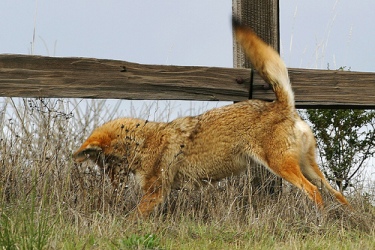
Nutrition

Coyotes are the most numerous and successful predators in North America. Unlike their close relative the wolf, pack strategy in hunting is seldom used. Their keen senses of smell and hearing allow them to locate and pounce on rodents in tall grasses or beneath snow before the prey is even seen, making them efficient lone hunters. Coyotes rely solely on their sharp teeth for capturing and killing prey, which they suffocate by grasping around the throat.
 Rabbits
and other small mammals make up the bulk of the diet for most of the
year, with carrion making up a bigger part during the winter months
when large animals are more likely to die of natural causes.
Hares, gophers, ground squirrels and mice account for over half of
the coyote’s diet, but consumption of birds, small reptiles, fish
and even insects has been observed. Vegetable matter such as
fruits and berries occasionally supplements the coyotes diet, but
for the most part they are carnivorous.
Rabbits
and other small mammals make up the bulk of the diet for most of the
year, with carrion making up a bigger part during the winter months
when large animals are more likely to die of natural causes.
Hares, gophers, ground squirrels and mice account for over half of
the coyote’s diet, but consumption of birds, small reptiles, fish
and even insects has been observed. Vegetable matter such as
fruits and berries occasionally supplements the coyotes diet, but
for the most part they are carnivorous.
Larger prey such as deer or elk are normally only attacked when they
are old, sick or injured, as the coyote's size does not make it easy
to attack these animals. Also, contrary to popular belief, coyotes
rarely prey on livestock and are not as much of a problem as ranchers make
them out to be. In a study done on coyotes in the Midwestern
and western United States, only twenty percent of coyote stomachs
contained remains of livestock animals.
prey on livestock and are not as much of a problem as ranchers make
them out to be. In a study done on coyotes in the Midwestern
and western United States, only twenty percent of coyote stomachs
contained remains of livestock animals.